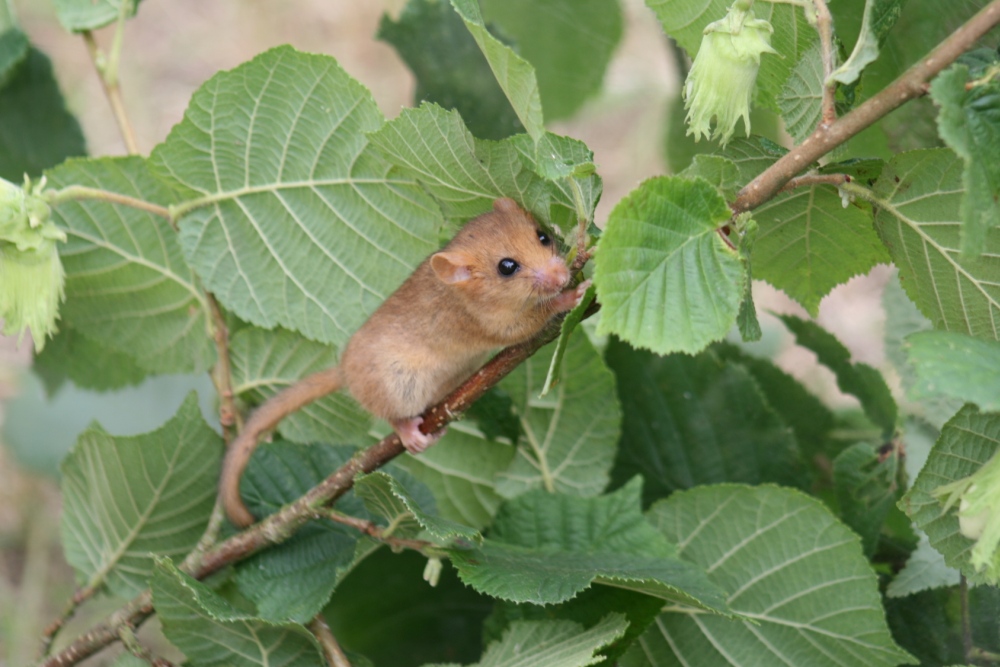Hazel (or Common) dormouse

Status
Native, localised to Wales and southern England
Population
930,000
Scientific name
Muscardinus avellanarius
Hazel dormice have golden-brown fur and large black eyes and, distinctively, they are the only small British mammal with a furry tail. They are nocturnal and spend almost all of their time in the branches of trees during the summer, rarely coming down to the ground. They have sometimes been found asleep in old bird nests but they weave their own nests (often in brambles or other shrubs) from strips of honeysuckle bark or a similar plant, surrounded by a layer of green leaves. When conditions are cold or wet, or if food is scarce, dormice curl up into a ball and go into a state similar to hibernation for a short time (called torpor) in order to save energy. Between October and May dormice hibernate in nests beneath the leaf litter on the forest floor or in the base of hedgerows.
Head-body length: 6.5 – 8 cm
Tail length: 80% of body length
Weight: 20g (but can be 35g prior to hibernation)
Lifespan: Up to five years
Reproduction
The average litter size is four and these are typically born in July or August but litters may be born as early as late May or early June. Young dormice are weaned after about one month but may remain with the mother as juveniles before they become independent and disperse. They must reach a weight of between 15-18g to survive the winter hibernation. Dormice usually just have a single litter but those that breed early may be able to have a second.
Diet
Dormice are successional feeders and require a range of foods to allow them to feed while they are active. In spring they will feed on the flowers of oak, hawthorn, sycamore and willow and as the season progresses move onto later flowering shrubs such as honeysuckle and bramble. During the summer they take advantage of caterpillars, aphids and wasp galls and then they fatten up for hibernation on fruits and berries such as blackberries and hazelnuts.
Habitat
Across its range dormice prefer the successional stage of woody vegetation; this is the new growth that arises after woodland management such as coppicing, ride widening, thinning or glade creation. In the UK the species tends to be more closely associated with old coppice woodland but they also occur in scrub habitat, old hedgerows and are sometimes found in conifer plantations.
Predators
Dormice live at low densities, even in ideal habitat and are not generally predated. They will however be eaten by owls, weasels, grey squirrels and cats while they are active and they can be eaten by badgers and wild boar when they are hibernating at ground level. It is likely however that the greatest threat to an individual dormice is winter survival.
Threats
Dormice are slow breeders and poor dispersers and generally live in older woodlands with a well-developed understory often linked by old hedgerows. In the majority of woodlands in Britain the management required to maintain a well-developed understory has ceased, making them less suitable for dormice. Inappropriate management of hedgerows, or their removal, has meant that woods that have lost their dormice will not be repopulated. The future effect of climate change on dormice is unknown.
Conservation status
GB Red List: Red list: Vulnerable (VU); a 2023 study suggests the Red List classification should be revised to Endangered (EN).
Population size and distribution
GB population: 930,000 but there is a lot of uncertainty around this estimate. Only found south of a line between Flintshire and Suffolk. See The State of Britain’s Dormice 2023.
Did you know?
Wood mice, bank voles and hazel dormice feed on hazelnuts by gnawing a round hole in the shell and each leaves distinctive marks. The tooth-marks of dormice run parallel to the edge of the hole, rather than outwards from its centre, so that the rim looks smooth, and there are few tooth-marks elsewhere on the nut. In contrast, the tooth-marks of mice and voles run outwards, so that the rim of the hole looks like the milled edge of a coin.
Our work to save dormice
We have been working to save hazel dormice in the UK for over 20 years. Find out about our campaigns and how you can help here.
